Articles
- Page Path
- HOME > J Korean Acad Nurs > Volume 44(5); 2014 > Article
-
Review Article
- Review of Meta-analysis Research on Exercise in South Korea
- Youngshin Song, Moonhee Gang, Sun-Ae Kim, In-Soo Shin
-
Journal of Korean Academy of Nursing 2014;44(5):459-470.
DOI: https://doi.org/10.4040/jkan.2014.44.5.459
Published online: October 31, 2014
1College of Nursing, Chungnam National University, Daejeon, Korea.
2College of Nursing·Research Institute of Nursing, Chungnam National University, Daejeon, Korea.
3Department of Nursing, Kkottongnae University, Cheongju, Korea.
4Department of Education, College of Education, Jeonju University, Jeonju, Korea.
- Address reprint requests to: Gang, Moonhee. College of Nursing, Chungnam National University, 266 Moonhwa-ro, Jung-gu, Daejeon 301-747, Korea. Tel: +82-42-580-8332, Fax: +82-42-580-8309, mhgang@cnu.ac.kr
© 2014 Korean Society of Nursing Science
This is an Open Access article distributed under the terms of the Creative Commons Attribution NoDerivs License. (http://creativecommons.org/licenses/by-nd/4.0/) If the original work is properly cited and retained without any modification or reproduction, it can be used and re-distributed in any format and medium.
Abstract
-
Purpose
- The purpose of this study was to evaluate the quality of meta-analysis regarding exercise using Assessment of Multiple Systematic Reviews (AMSTAR) as well as to compare effect size according to outcomes.
-
Methods
- Electronic databases including the Korean Studies Information Service System (KISS), the National Assembly Library and the DBpia, HAKJISAand RISS4U for the dates 1990 to January 2014 were searched for 'meta-analysis' and 'exercise' in the fields of medical, nursing, physical therapy and physical exercise in Korea. AMSTAR was scored for quality assessment of the 33 articles included in the study. Data were analyzed using descriptive statistics, t-test, ANOVA and χ2-test.
-
Results
- The mean score for AMSTAR evaluations was 4.18 (SD=1.78) and about 67% were classified at the low-quality level and 30% at the moderate-quality level. The scores of quality were statistically different by field of research, number of participants, number of databases, financial support and approval by IRB. The effect size that presented in individual studies were different by type of exercise in the applied intervention.
-
Conclusion
- This critical appraisal of meta-analysis published in various field that focused on exercise indicates that a guideline such as the PRISMA checklist should be strongly recommended for optimum reporting of meta-analysis across research fields.
- 1. Yoo JY, Oh EG. Level of beliefs, knowledge and performance for evidence-based practice among nurses experienced in preceptor role. J Korean Acad Nurs Adm. 2012;18(2):202–212. http://dx.doi.org/10.11111/jkana.2012.18.2.202Article
- 2. Shin IS, Park EY. Review of the meta-analysis research in special education and related field. Korean J Phys Mult Disabil. 2011;54(4):157–176.Article
- 3. Kim JH, Kim AK. A quality assessment of meta-analyses of nursing in South Korea. J Korean Acad Nurs. 2013;43(6):736–745. http://dx.doi.org/10.4040/jkan.2013.43.6.736ArticlePubMed
- 4. Jang DH, Shin IS. Historical development of meta-analysis as an educational research methodology. J Curric Eval. 2011;14(3):309–332.ArticlePDF
- 5. Moher D, Cook DJ, Eastwood S, Olkin I, Rennie D, Stroup DF. Improving the quality of reports of meta-analyses of randomised controlled trials: The QUOROM statement. Quality of reporting of meta-analyses. Lancet. 1999;354(9193):1896–1900.PubMed
- 6. Dixon E, Hameed M, Sutherland F, Cook DJ, Doig C. Evaluating metaanalyses in the general surgical literature: A critical appraisal. Ann Surg. 2005;241(3):450–459.PubMedPMC
- 7. MacDonald SL, Canfield SE, Fesperman SF, Dahm P. Assessment of the methodological quality of systematic reviews published in the urological literature from 1998 to 2008. J Urol. 2010;184(2):648–653. http://dx.doi.org/10.1016/j.juro.2010.03.127ArticlePubMed
- 8. Dijkman BG, Abouali JA, Kooistra BW, Conter HJ, Poolman RW, Kulkarni AV, et al. Twenty years of meta-analyses in orthopaedic surgery: Has quality kept up with quantity? J Bone Joint Surg Am. 2010;92(1):48–57. http://dx.doi.org/10.2106/jbjs.i.00251ArticlePubMed
- 9. De Vito C, Manzoli L, Marzuillo C, Anastasi D, Boccia A, Villari P. A systematic review evaluating the potential for bias and the methodological quality of meta-analyses in vaccinology. Vaccine. 2007;25(52):8794–8806. http://dx.doi.org/10.1016/j.vaccine.2007.10.034ArticlePubMed
- 10. Melchiors AC, Correr CJ, Venson R, Pontarolo R. An analysis of quality of systematic reviews on pharmacist health interventions. Int J Clin Pharm. 2012;34(1):32–42. http://dx.doi.org/10.1007/s11096-011-9592-0ArticlePubMedPDF
- 11. Papageorgiou SN, Papadopoulos MA, Athanasiou AE. Evaluation of methodology and quality characteristics of systematic reviews in orthodontics. Orthod Craniofac Res. 2011;14(3):116–137. http://dx.doi.org/10.1111/j.1601-6343.2011.01522.xArticlePubMed
- 12. Suebnukarn S, Ngamboonsirisingh S, Rattanabanlang A. A systematic evaluation of the quality of meta-analyses in endodontics. J Endod. 2010;36(4):602–608. http://dx.doi.org/10.1016/j.joen.2009.12.019ArticlePubMed
- 13. Kim YK. A review of the meta-analysis in major academic journal of business management in Korea. Korea J Bus Adm. 2010;23(4):1833–1858.
- 14. Suh MO. The review of meta-analysis and research methodology proposed. Korean J Educ Res. 2011;49(2):1–23.
- 15. Cook DJ, Sackett DL, Spitzer WO. Methodologic guidelines for systematic reviews of randomized control trials in health care from the potsdam consultation on meta-analysis. J Clin Epidemiol. 1995;48(1):167–171.ArticlePubMed
- 16. Stroup DF, Berlin JA, Morton SC, Olkin I, Williamson GD, Rennie D, et al. Meta-analysis of observational studies in epidemiology: A proposal for reporting. Meta-analysis of observational studies in epidemiology (MOOSE) group. JAMA. 2000;283(15):2008–2012.ArticlePubMed
- 17. Moher D, Liberati A, Tetzlaff J, Altman DG. Preferred reporting items for systematic reviews and meta-analyses: The PRISMA statement. J Clin Epidemiol. 2009;62(10):1006–1012. http://dx.doi.org/10.1016/j.jclinepi.2009.06.005ArticlePubMed
- 18. Oxman AD, Guyatt GH, Singer J, Goldsmith CH, Hutchison BG, Milner RA, et al. Agreement among reviewers of review articles. J Clin Epidemiol. 1991;44(1):91–98.ArticlePubMed
- 19. Shea BJ, Grimshaw JM, Wells GA, Boers M, Andersson N, Hamel C, et al. Development of AMSTAR: A measurement tool to assess the methodological quality of systematic reviews. BMC Med Res Methodol. 2007;7:10. http://dx.doi.org/10.1186/1471-2288-7-10ArticlePubMedPMCPDF
- 20. Shea BJ, Hamel C, Wells GA, Bouter LM, Kristjansson E, Grimshaw J, et al. AMSTAR is a reliable and valid measurement tool to assess the methodological quality of systematic reviews. J Clin Epidemiol. 2009;62(10):1013–1020. http://dx.doi.org/10.1016/j.jclinepi.2008.10.009Article
- 21. Kim SY, Park JE, Seo HJ, Lee YJ, Jang BH, Son HJ, et al. NECA's guidance for undertaking systematic reviews and meta-analyses for intervention. Seoul: National Evidence-based Healthcare Collaborating Agency; 2011.
- 22. Matjasko JL, Vivolo-Kantor AM, Massetti GM, Holland KM, Holt MK, Cruz JD. A systematic meta-review of evaluations of youth violence prevention programs: Common and divergent findings from 25 years of meta-analyses and systematic reviews. Aggress Violent Behav. 2012;17(6):540–552. http://dx.doi.org/10.1016/j.avb.2012.06.006ArticlePubMed
- 23. Cohen J. Statistical power analysis for the behavioral sciences. 2nd ed. Hillsdale, NJ: Lawrence Erlbaum Associates; 1988.
- 24. Burda BU, Norris SL, Holmer HK, Ogden LA, Smith ME. Quality varies across clinical practice guidelines for mammography screening in women aged 40-49 years as assessed by AGREE and AMSTAR instruments. J Clin Epidemiol. 2011;64(9):968–976. http://dx.doi.org/10.1016/j.jclinepi.2010.12.005ArticlePubMed
- 25. Lee MH, Baek SS. A meta-analysis of optimal exercise time and frequence for fat loss in overweight elementary school students. Korean J Elem Phys Educ. 2012;18(2):199–210.
- 26. Ho SS, Dhaliwal SS, Hills AP, Pal S. The effect of 12 weeks of aerobic, resistance or combination exercise training on cardiovascular risk factors in the overweight and obese in a randomized trial. BMC Public Health. 2012;12:704. http://dx.doi.org/10.1186/1471-2458-12-704ArticlePubMedPMCPDF
- 27. Davidson LE, Hudson R, Kilpatrick K, Kuk JL, McMillan K, Janiszewski PM, et al. Effects of exercise modality on insulin resistance and functional limitation in older adults: A randomized controlled trial. Arch Intern Med. 2009;169(2):122–131. http://dx.doi.org/10.1001/archinternmed.2008.558ArticlePubMed
- 28. Chung C, Lee S, Hwang SW, Park EH. Systematic review of exercise effects on health outcomes in women with breast cancer. Asian Nurs Res. 2013;7(3):149–159. http://dx.doi.org/10.1016/j.anr.2013.07.005Article
- 29. Sung KS, Yoon YM, Kim EJ. Meta-analysis of the effects of obesity management program for children. Child Health Nurs Res. 2013;19(4):262–269. http://dx.doi.org/10.4094/chnr.2013.19.4.262ArticlePDF
- 30. McCartney K, Rosenthal R. Effect size, practical importance, and social policy for children. Child Dev. 2000;71(1):173–180.ArticlePubMed
REFERENCES
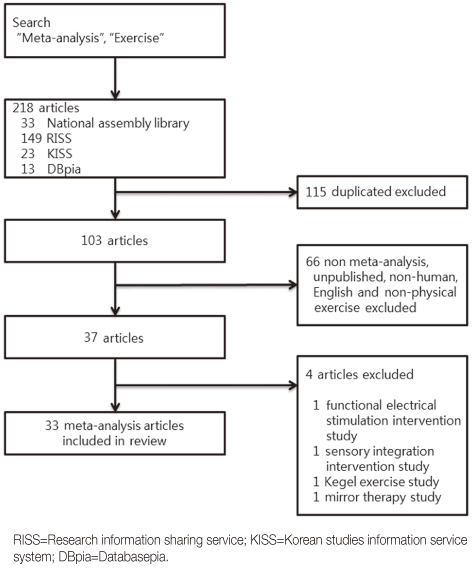
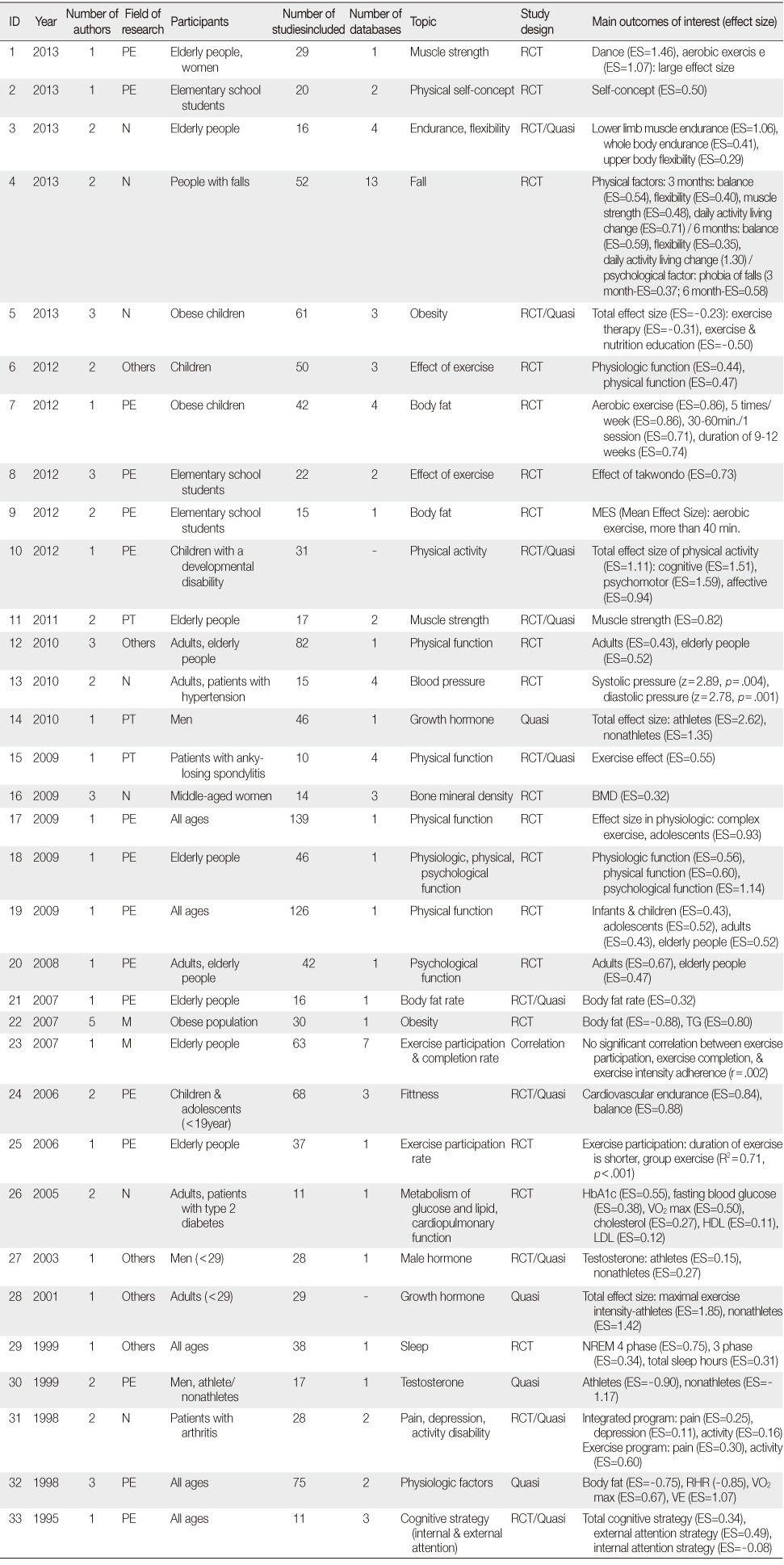
N=Nursing; M=Medical; PE=Physical exercise; PT=Physical therapy; Others=Education etc.; RCT=Randomized clinical trial; Quasi=Quasi experimental; BMD=Bone marrow density; HbA1C=Glycosylated hemoglobin; HDL=High density lipoprotein; LDL=Low density lipoprotein; NREM=Non rapid eye movement; RHR=Resting heart rate; VE=Ventilation; VO2 Max=Maximal oxygen uptake.
Figure & Data
REFERENCES
Citations

- Effectiveness of sensory integration therapy in children, focusing on Korean children: A systematic review and meta-analysis
Seri Oh, Jong-Sik Jang, A-Ra Jeon, Geonwoo Kim, Mihwa Kwon, Bahoe Cho, Narae Lee
World Journal of Clinical Cases.2024; 12(7): 1260. CrossRef - A Methodological Quality Evaluation of Meta-Analyses on Nursing Home Research: Overview and Suggestions for Future Directions
In-Soo Shin, Juh-Hyun Shin, Dong-Eun Jang, Jiyeon Lee
International Journal of Environmental Research and Public Health.2022; 19(1): 505. CrossRef - Methodological Quality Assessment of Meta-Analyses in the Field of Korean Occupational Therapy Using the Korean Journal of Occupational Therapy
Yoo-Im Choi, Se-Yun Kim
Journal of Korean Society of Occupational Therapy.2020; 28(3): 71. CrossRef - Methodological Qualitative Evaluation of Meta-analysis Studies in Sport Management
Sanghyun Park, Minseok Kwag
The Korean Journal of Physical Education.2018; 57(1): 247. CrossRef - Evaluation of methodological quality of meta-analysis studies in early childhood education
PARK SEO-HYUN
Korean Journal of Early Childhood Education.2018; 38(5): 131. CrossRef - The Feature of the Program components in the Meta Analysis Research: Evidence Based Program Development Perspective
In Hae Seo, Kong Gye-Soon
Korean Journal of Social Welfare Studies.2018; 49(3): 247. CrossRef - Trends in Evidence-based Nursing Research in South Korea
Seang Ryu, Sun Weon Yun, Yun Sook Kim
Journal of Korean Academy of Nursing Administration.2017; 23(4): 385. CrossRef - A Quality Assessment of Systematic Review of Oriental Medicine in South Korea
Yun-Young Kim, Hye Sun Hyun
Journal of Digital Convergence.2015; 13(10): 549. CrossRef - Methodological Quality of Meta-Analyses on the Elderly in Korea
송영신, 김선애, 강문희
Korean Journal of Local Government & Administration Studies.2014; 28(4): 349. CrossRef

Figure 1
Study Characteristics of Studies Included (N=33)
N=Nursing; M=Medical; PE=Physical exercise; PT=Physical therapy; Others=Education etc.; RCT=Randomized clinical trial; Quasi=Quasi experimental; BMD=Bone marrow density; HbA1C=Glycosylated hemoglobin; HDL=High density lipoprotein; LDL=Low density lipoprotein; NREM=Non rapid eye movement; RHR=Resting heart rate; VE=Ventilation; VO2 Max=Maximal oxygen uptake.
Scores of Assessment of Multiple Systematic Reviews
Comparison of AMSTAR Scores by Characteristics of the Meta-analyses Included
SCI (E)=Science citation index expanded; SSCI=Social science citation index; KCI=Korean citation index; RCT=Randomized clinical trial; Quasi=Quasi experimental.
Classification of Effect Sizes by Study Characteristics (N=170)
*Fisher's exact test.
N=Nursing; M=Medical; PE=Physical exercise; PT=Physical therapy; Others=Education etc.; RCT=Randomized clinical trial; Quasi=Quasi experimental; BMD=Bone marrow density; HbA1C=Glycosylated hemoglobin; HDL=High density lipoprotein; LDL=Low density lipoprotein; NREM=Non rapid eye movement; RHR=Resting heart rate; VE=Ventilation; VO2 Max=Maximal oxygen uptake.
SCI (E)=Science citation index expanded; SSCI=Social science citation index; KCI=Korean citation index; RCT=Randomized clinical trial; Quasi=Quasi experimental.
*Fisher's exact test.
 KSNS
KSNS
 E-SUBMISSION
E-SUBMISSION
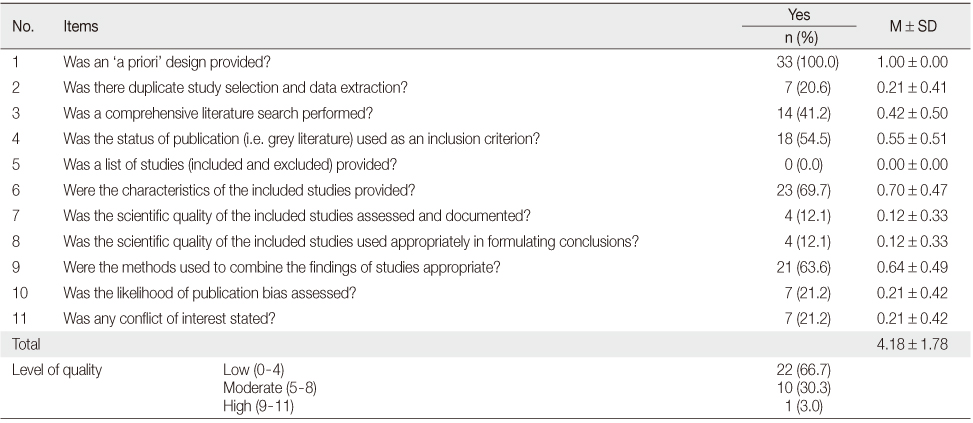
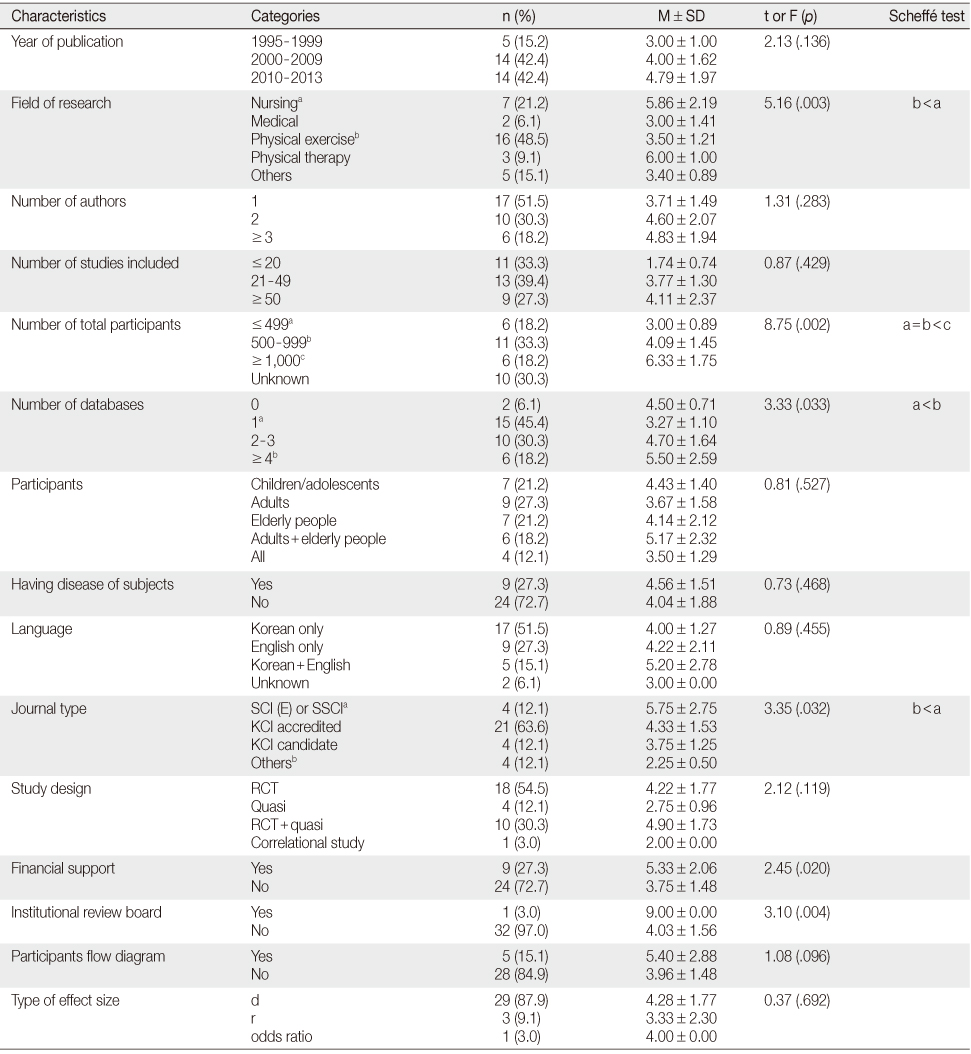
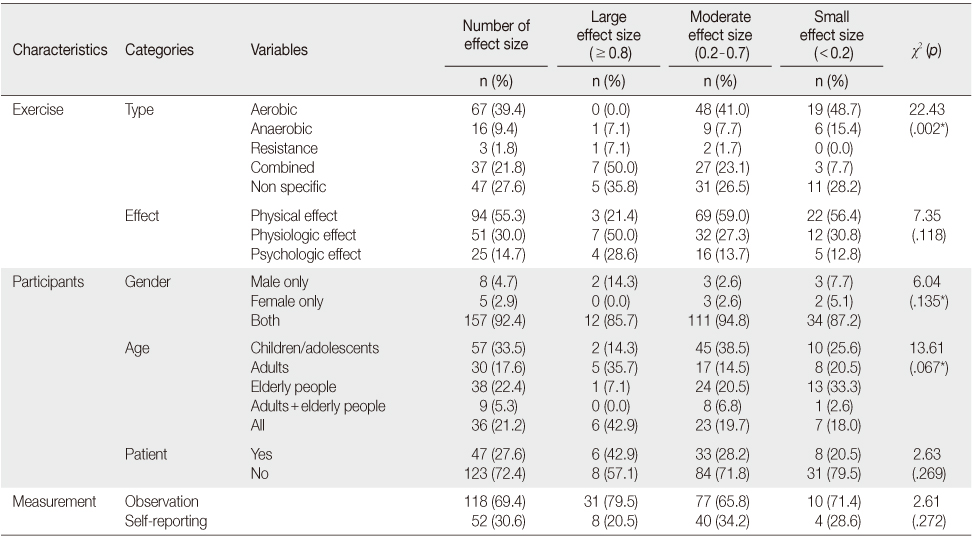
 Cite
Cite

